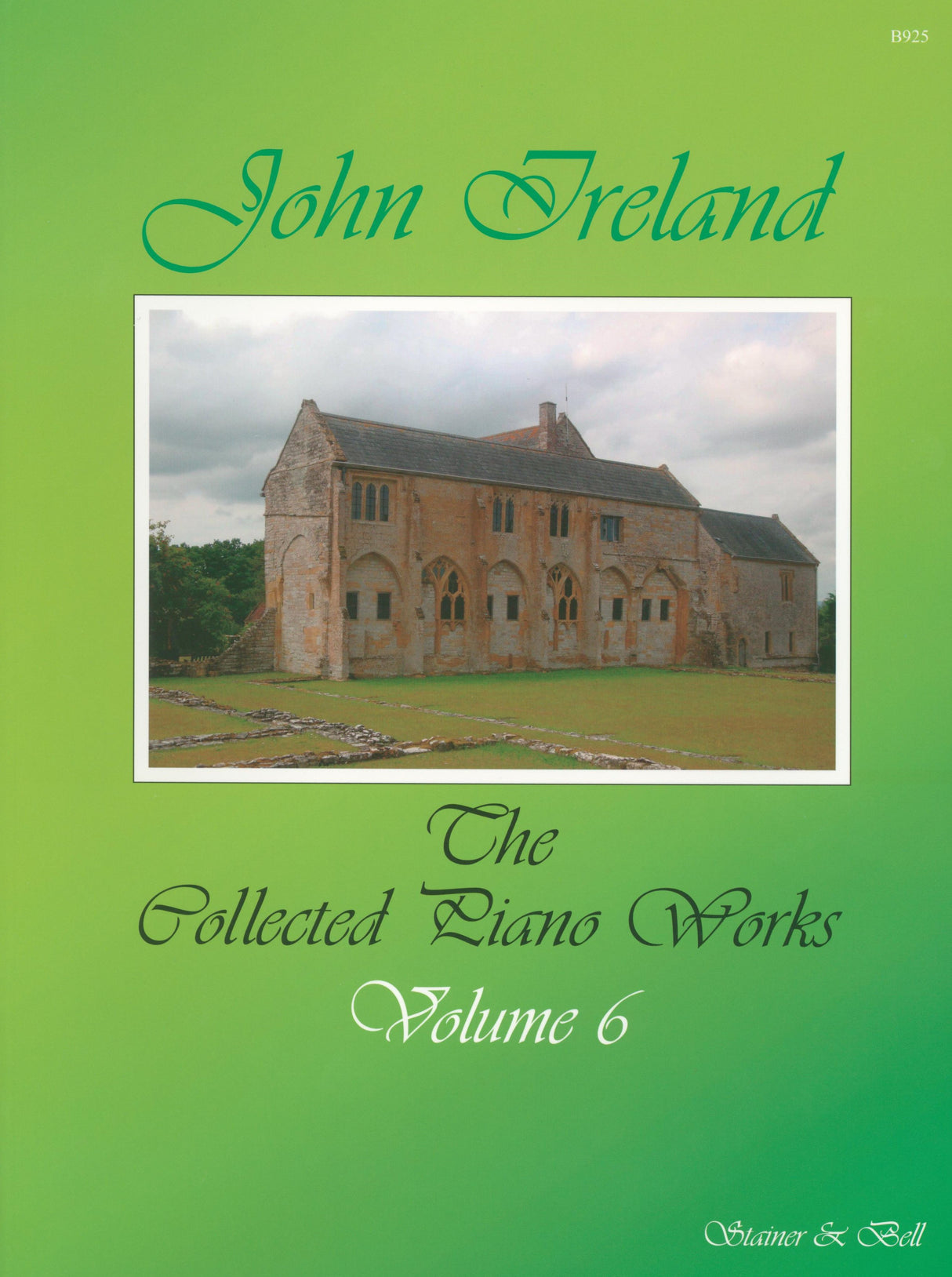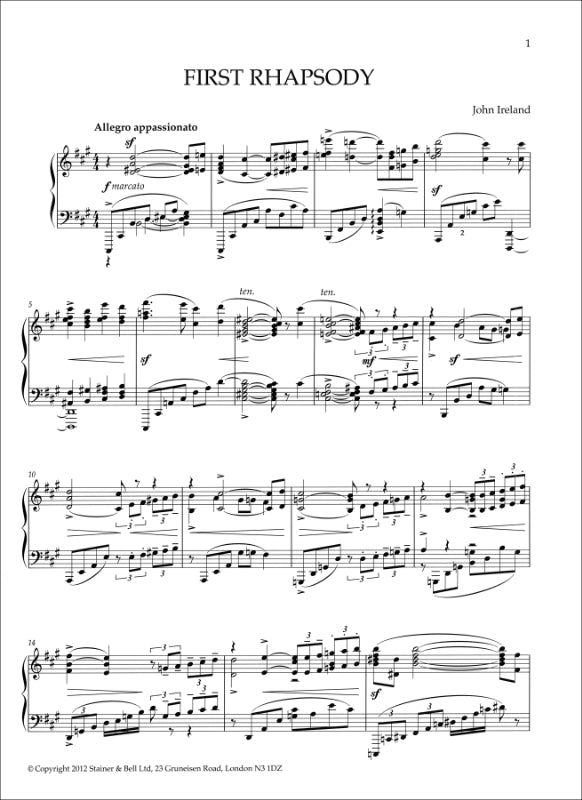Ireland: The Collected Works for Piano - Volume 6
In stock and typically ships within 1 business day.
- Composer: John Ireland (1879-1962)
- Instrumentation: Piano
- ISMN:
- Size: 9.1 x 12.0 inches
Description
Description This long-awaited addition to The Collected Piano Works of John Ireland contains a wealth of music either previously unknown or out-of-print which will be enthusiastically received not only by pianists but by all admirers of this remarkable composer. During his lifetime Ireland suppressed a number of his early works considered to be unrepresentative of his mature style, but which fortunately have survived, several now being preserved in the British Library. Chief of these is the First Rhapsody, a striking and virtuosic score here published for the first time. Already twice-recorded, this twelve-minute work is undoubtedly in A Major addition to the repertoire of British romantic keyboard music; and, like A Sea Idyll, available here for the first time in its original three-movements, it significantly enhances our understanding of the formative stages of Ireland's path to artistic maturity.
Volume Six of the Collected Piano Works also contains a number of transcriptions, made by Ireland for a diversity of purposes. His arrangement of Bach's Meine Seele erhebt den Herren was a contribution to the famous A Bach Book for Harriet Cohen of 1932. in contrast, his hefty piano-solo version of the orchestral Epic March of 1942 was in part a patriotic contribution to the war effort made by an elderly composer who had narrowly escaped the German occupation of his beloved Guernsey in May 1940. There are two pieces which besides being attractive in themselves are of considerable musicological significance for those interested in Ireland's compositional process. Long out-of-print, Indian Summer is an earlier version of The Cherry Tree from the suite Greenways, while Ballerina survived in manuscript as a forerunner of Columbine – like Indian Summer, a fascinatingly distinctive variation on the more familiar composition. All four show Ireland's mastery at polishing and refining an idiom based on an exquisite ear for keyboard harmony and texture. It is a mastery no less evident in the Edwardian salon idiom of the brief Villanella and in the Elegy and Menuet from A Downland Suite, originally for brass band. with such a wealth of material furnishing insights into Ireland's creative development, it is appropriate that Volume Six should also present one of the earliest of all his compositions for piano, a Pastoral written in 1896. Though brief, it is a rare and prescient example of his music before he began his studies with Stanford. in it, Fiona Richards, a leading expert on the composer, identifies ‘germs of the composer's pastoral style that were to be refined over the next twenty years,' and ‘a pervasive melancholy and pensiveness that was to become a feature of Ireland's mature pieces.'
Works:
- First Rhapsody
- A Sea Idyll (I)
- A Sea Idyll (II)
- A Sea Idyll (III)
- Villanella
- Pastoral
- Elegy from A Dowland Suite
- Menuet from A Dowland Suite
- Epich March
- Meine Seele erhebt den Herren (from A Bach Book for Harriet Cohen)
- Indian Summer
- Ballerina
Publishers use a lot of words to describe what they sell, and we know it can be confusing. We've tried to be as clear as possible to make sure you get exactly what you are looking for. Below are descriptions of the terms that we use to describe the various formats that music often comes in.
Choral Score
A score for vocalists that only contains the vocal lines. The instrumental parts are not there for reference. Generally, cheaper than a vocal score and requires multiple copies for purchase.
Facsimile
Reproductions of the original hand-written scores from the composer.
Full Score
For ensemble music, this indicates that the edition contains all parts on a single system (there are not separate parts for each player). In larger ensembles, this is for the conductor.
Hardcover
Hardbound. Generally either linen-covered or half-leather.
Orchestral Parts
Similar to a wind set, this is a collection of parts. In the case of strings, the numbers listed are the number of copies included, though generally these are available individually (often with minimum quantities required).
Paperback
When publishers offer multiple bindings (e.g. hardcover) or study scores, this is the "standard" version. If you're planning to play the music, this is probably what you want.
Performance / Playing Score
A score of the music containing all parts on one system, intended for players to share. There are not separate parts for each player.
Set of Parts
For ensemble music, this indicates that there are separate individual parts for each player.
Solo Part with Piano Reduction
For solo pieces with orchestra, this is a version that contains a piano reduction of the orchestra parts. For piano pieces, two copies are typically needed for performance.
Study Score
A small (think choral size) copy of the complete score meant for studying, and not playing. They make great add-ons when learning concertos and small chamber works.
Vocal Score
A score prepared for vocalists that includes the piano/organ part or a reduction of the instrumental parts.
Wind Set
For orchestral music, this is a collection of wind and percussion parts. The specific quantities of each instrument are notated.
With Audio
In addition to the printed music, the edition contains recordings of the pieces. This may be an included CD, or access to files on the internet.
With / Without Fingering (Markings)
Some publishers prepare two copies - a pure Urtext edition that includes no fingering (or bowing) suggestions and a lightly edited version that includes a minimal number of editorial markings.



